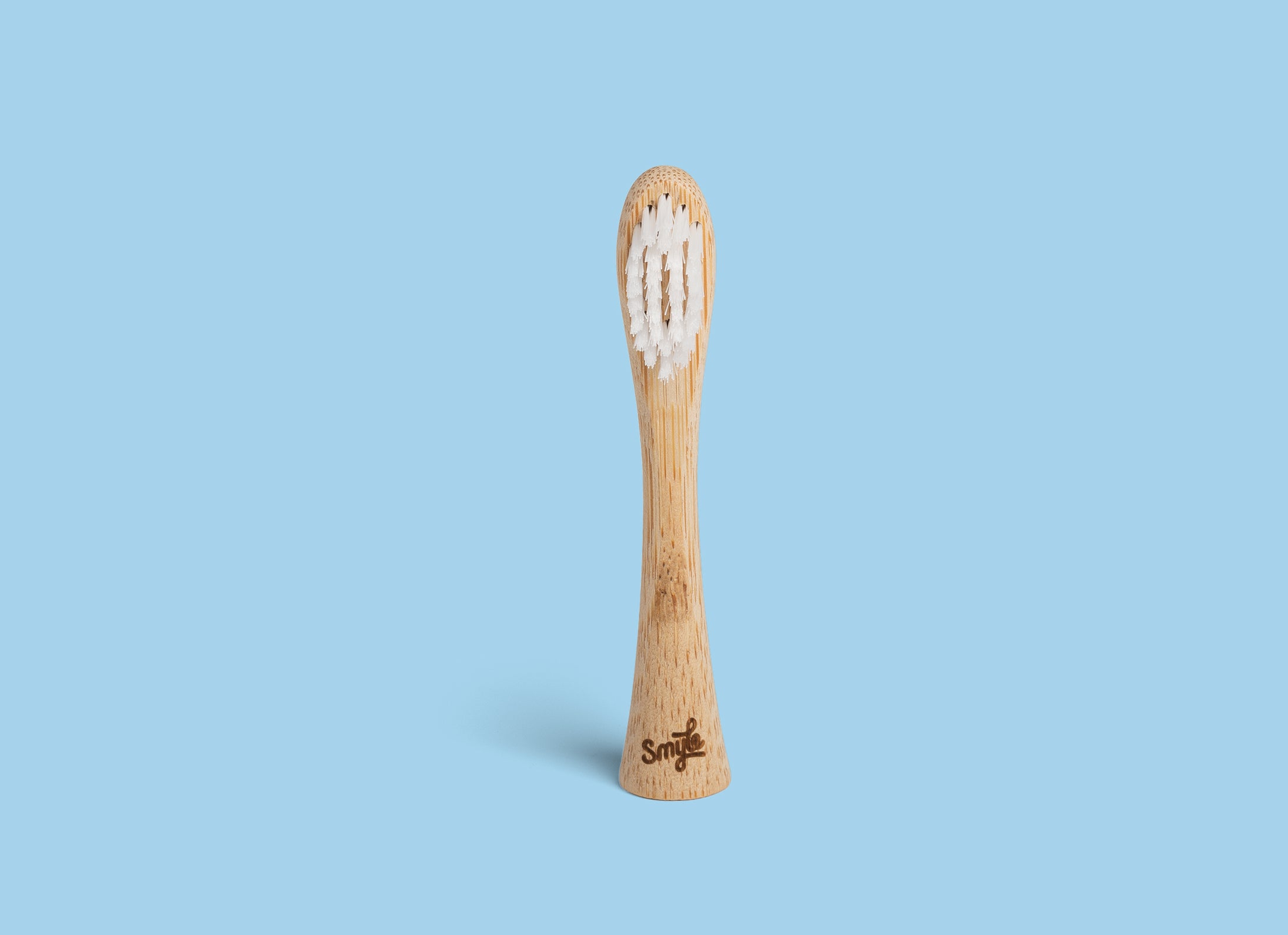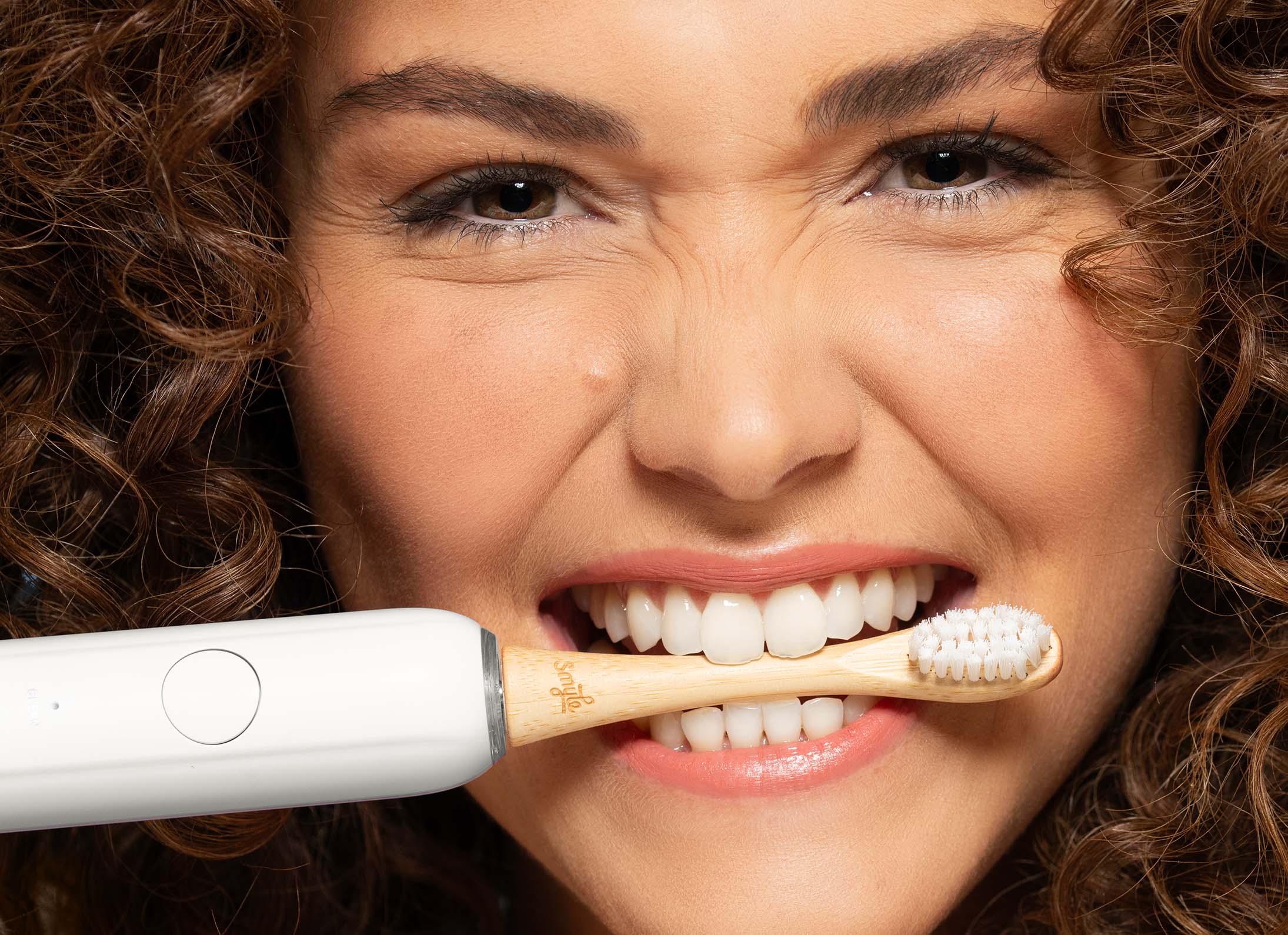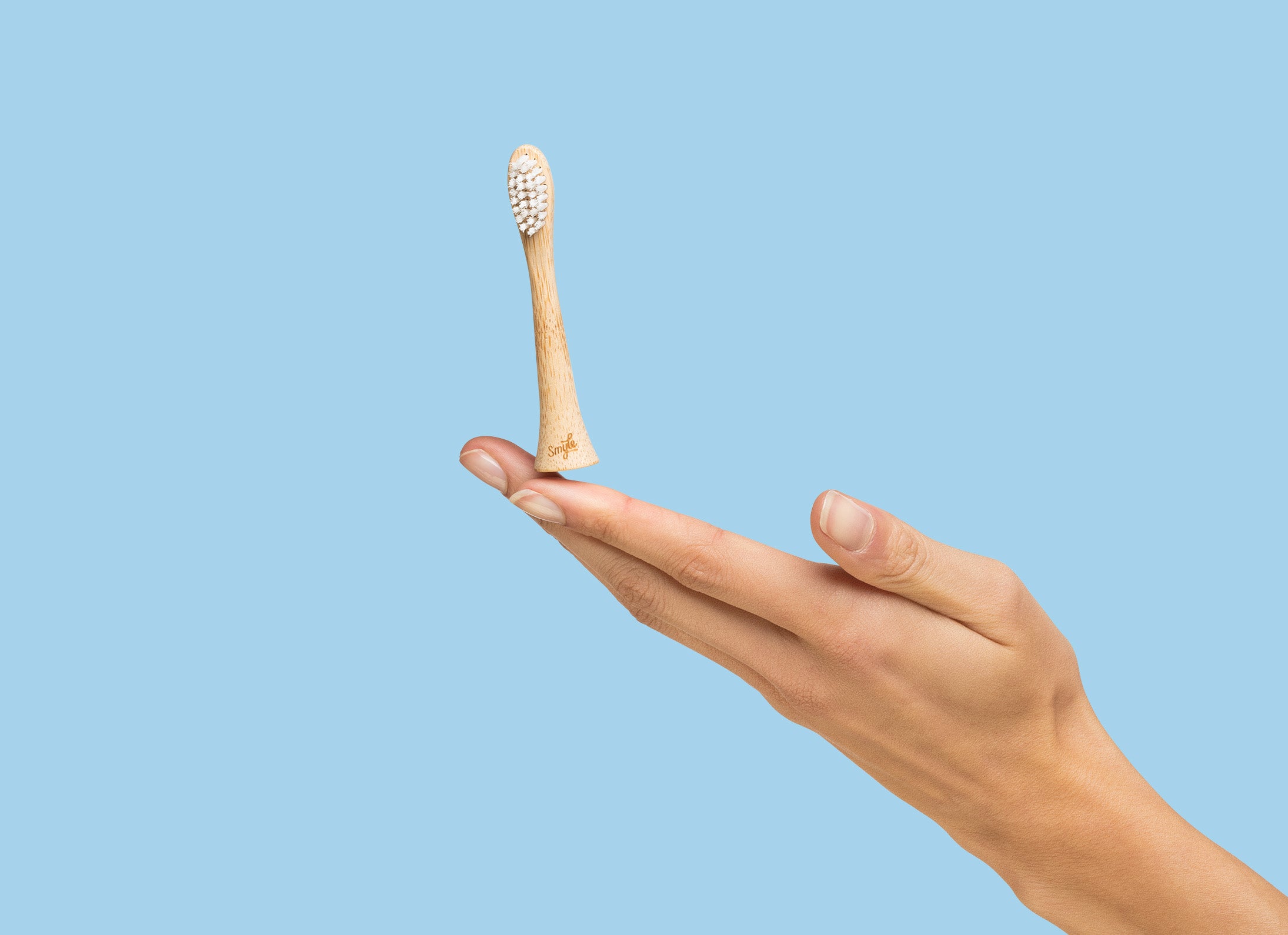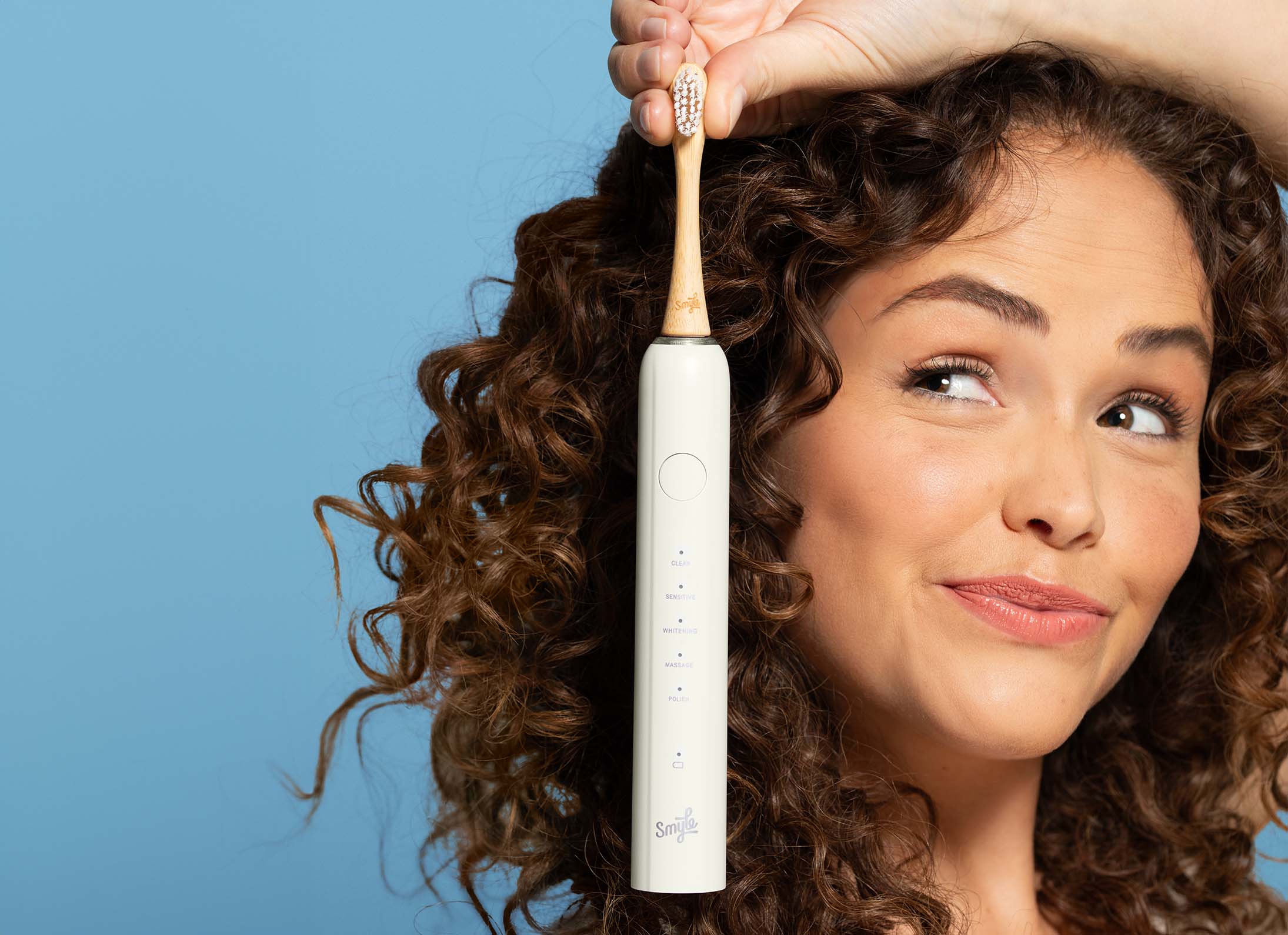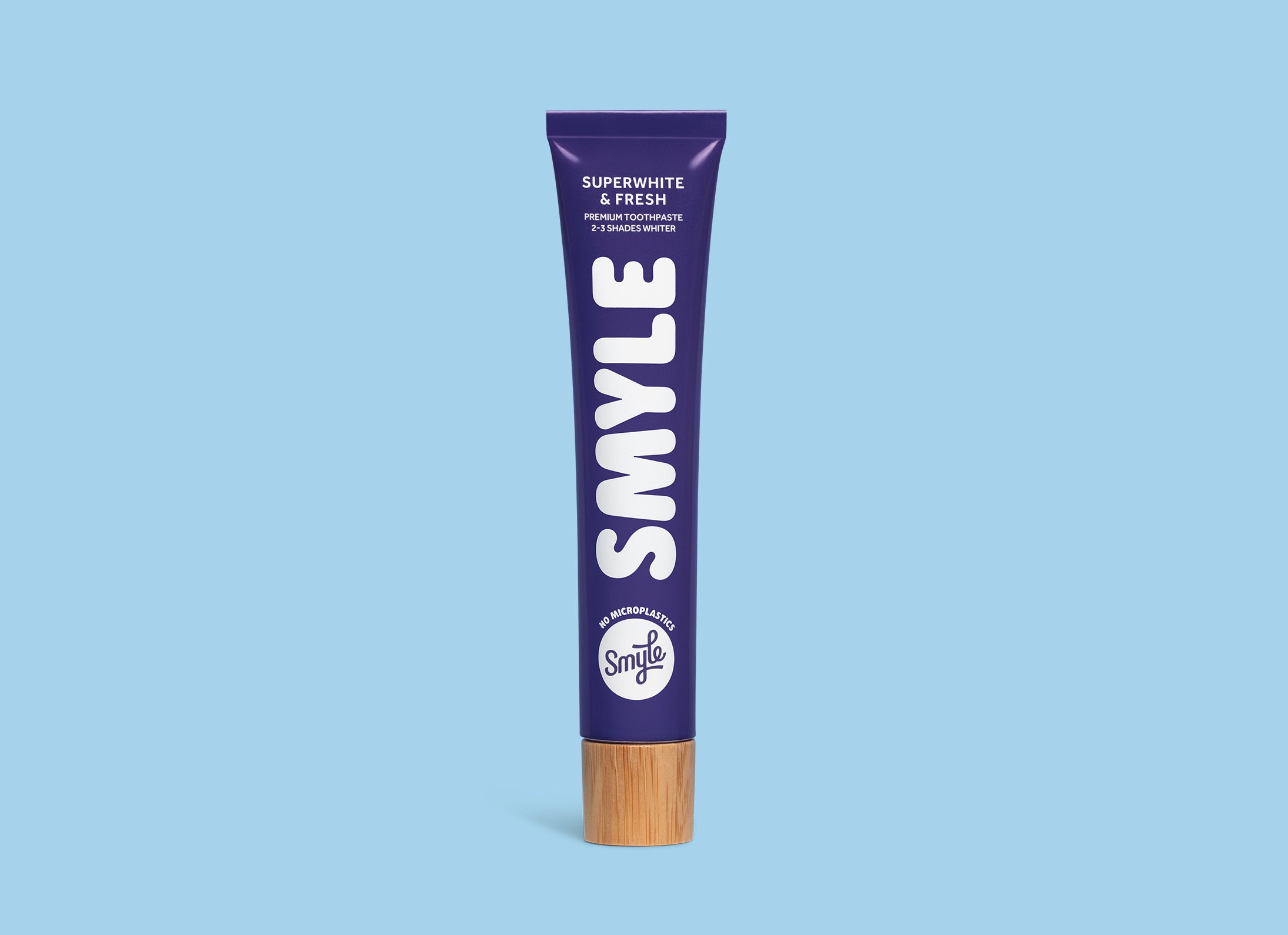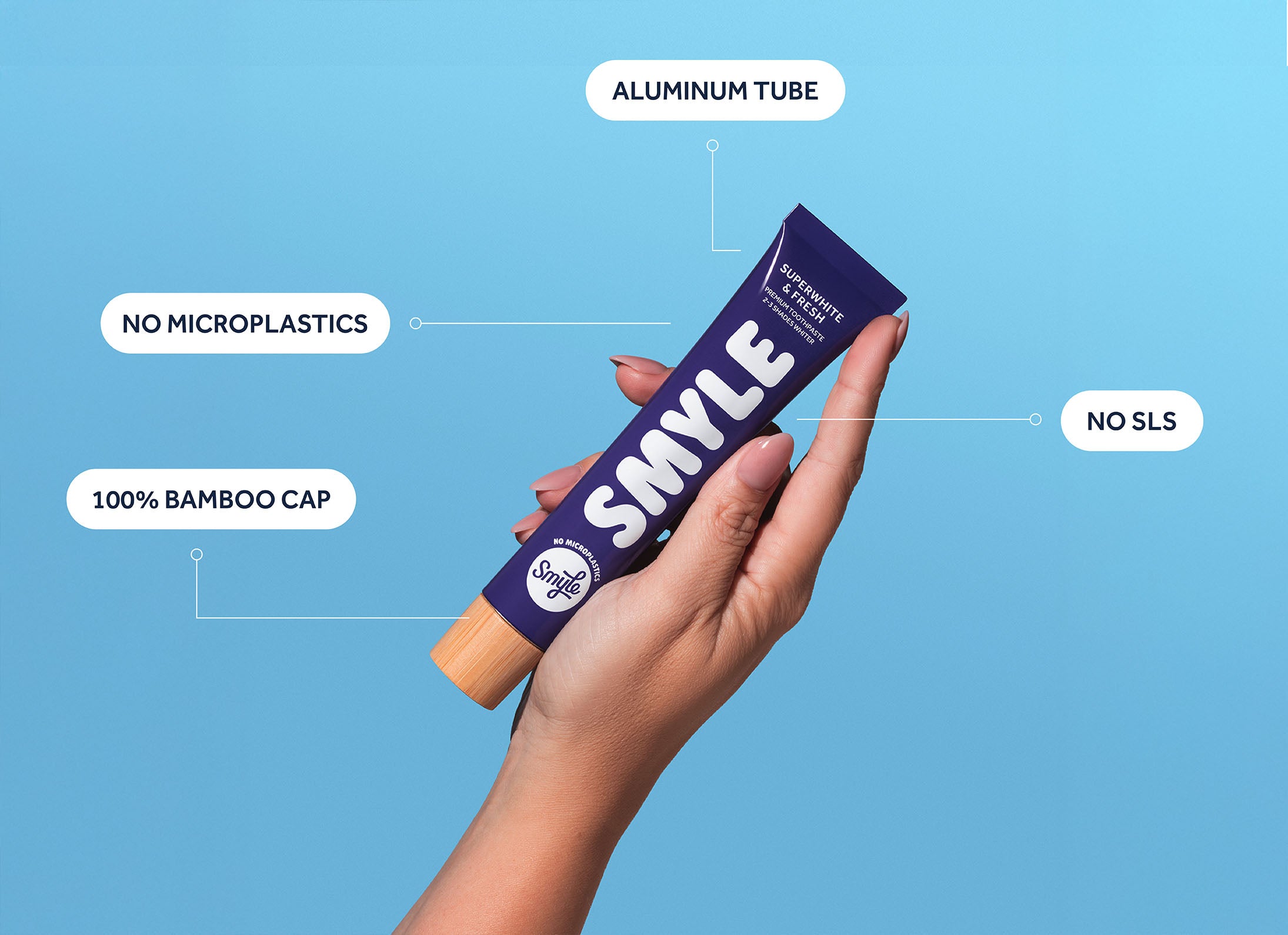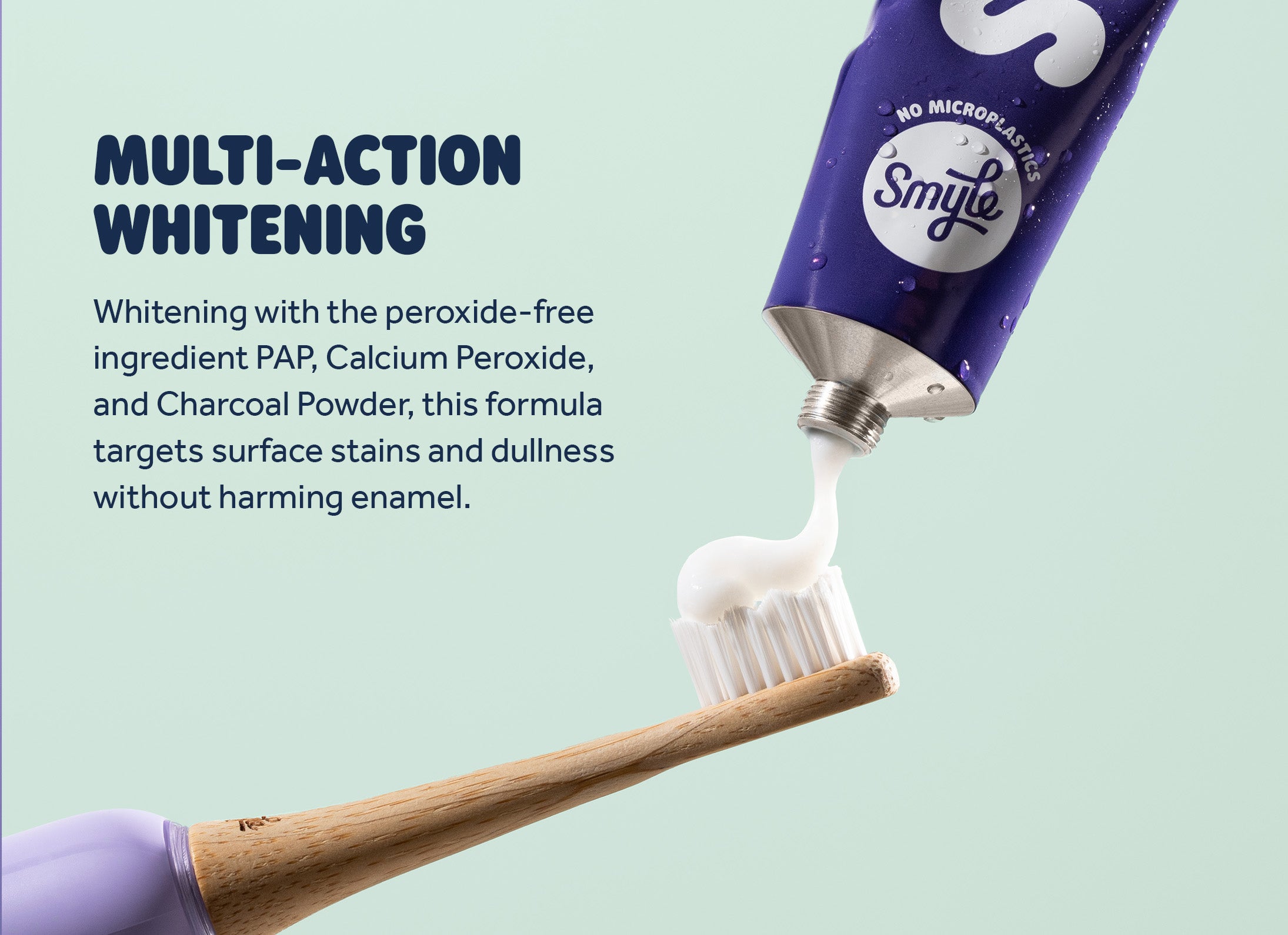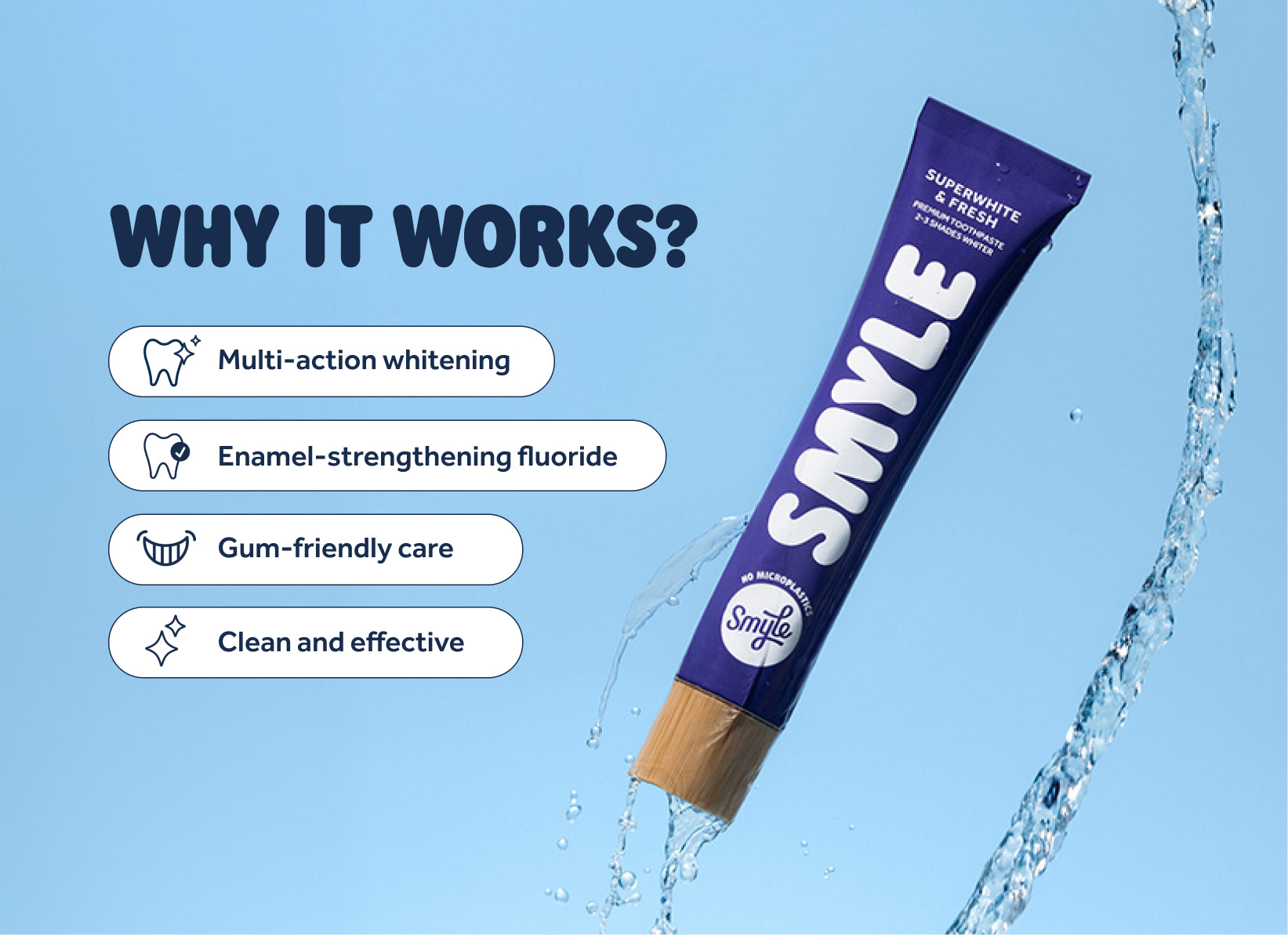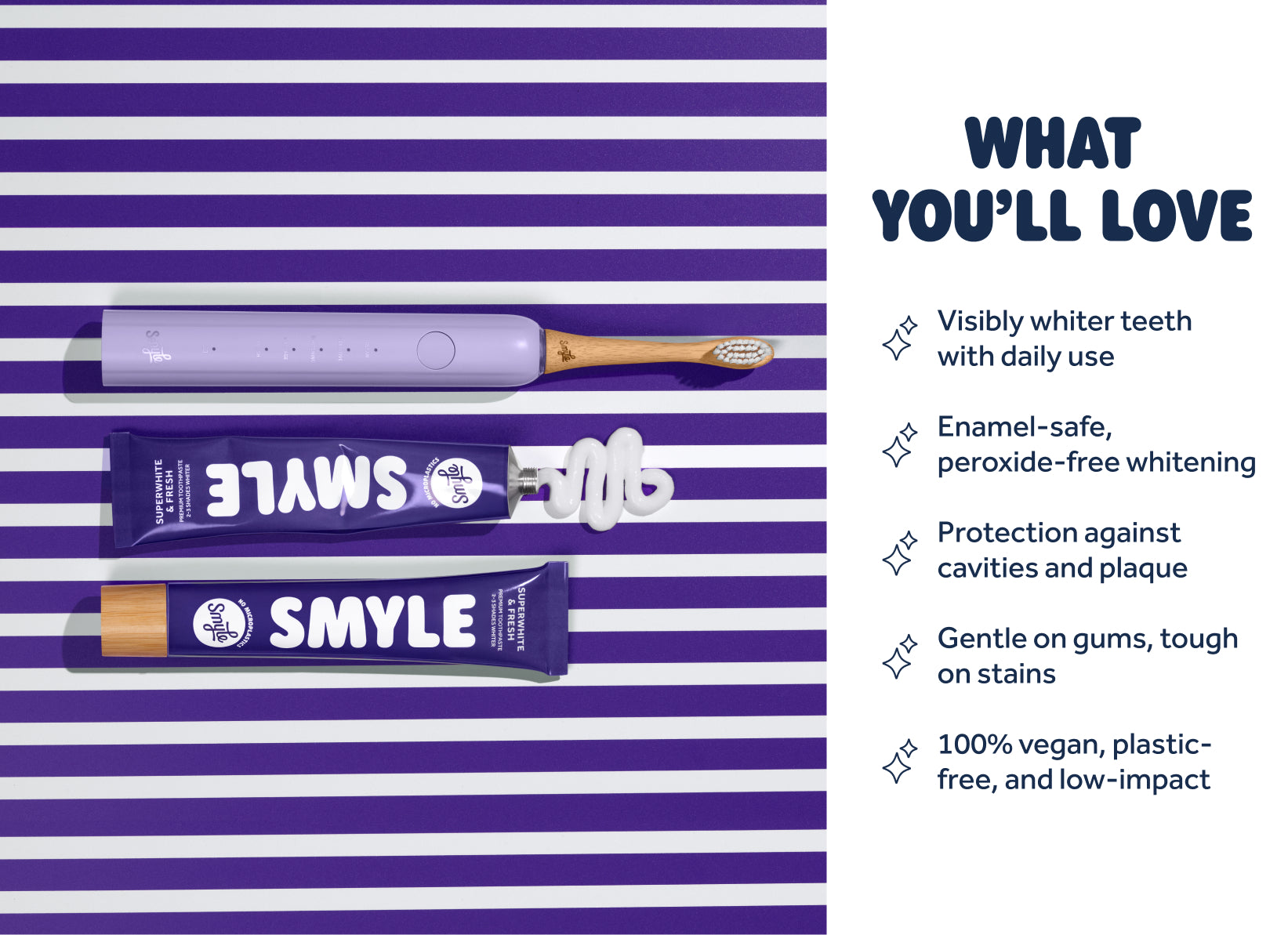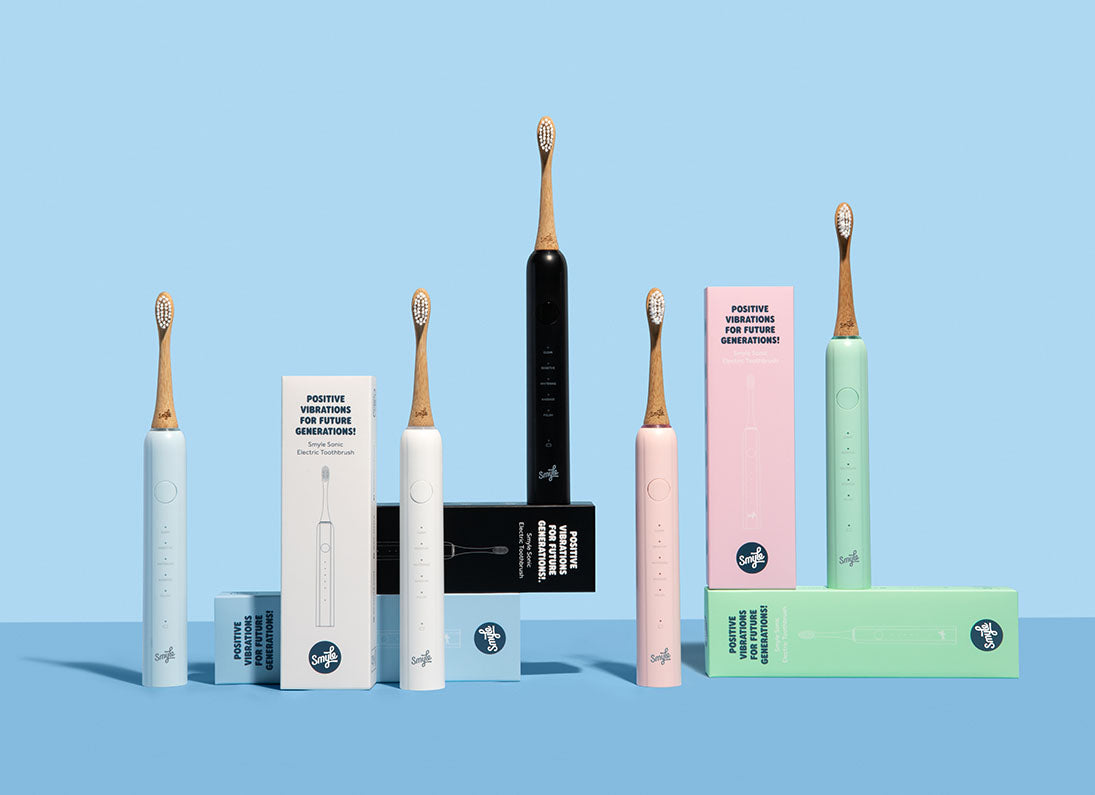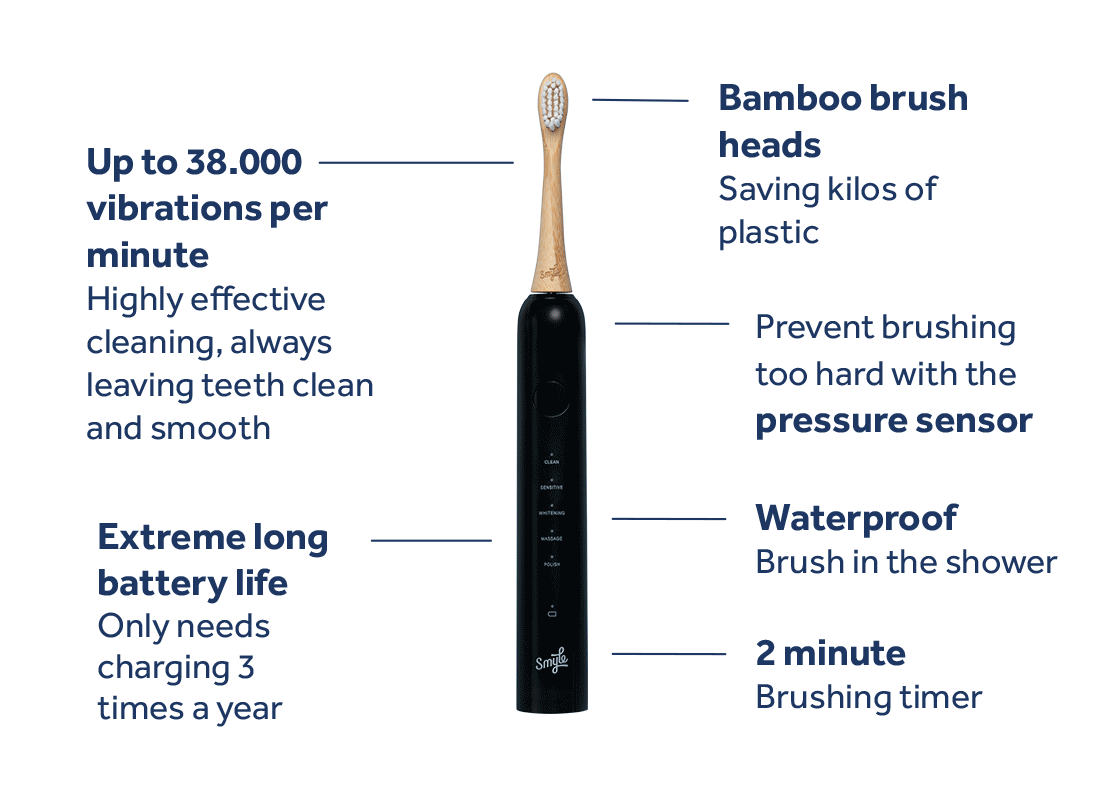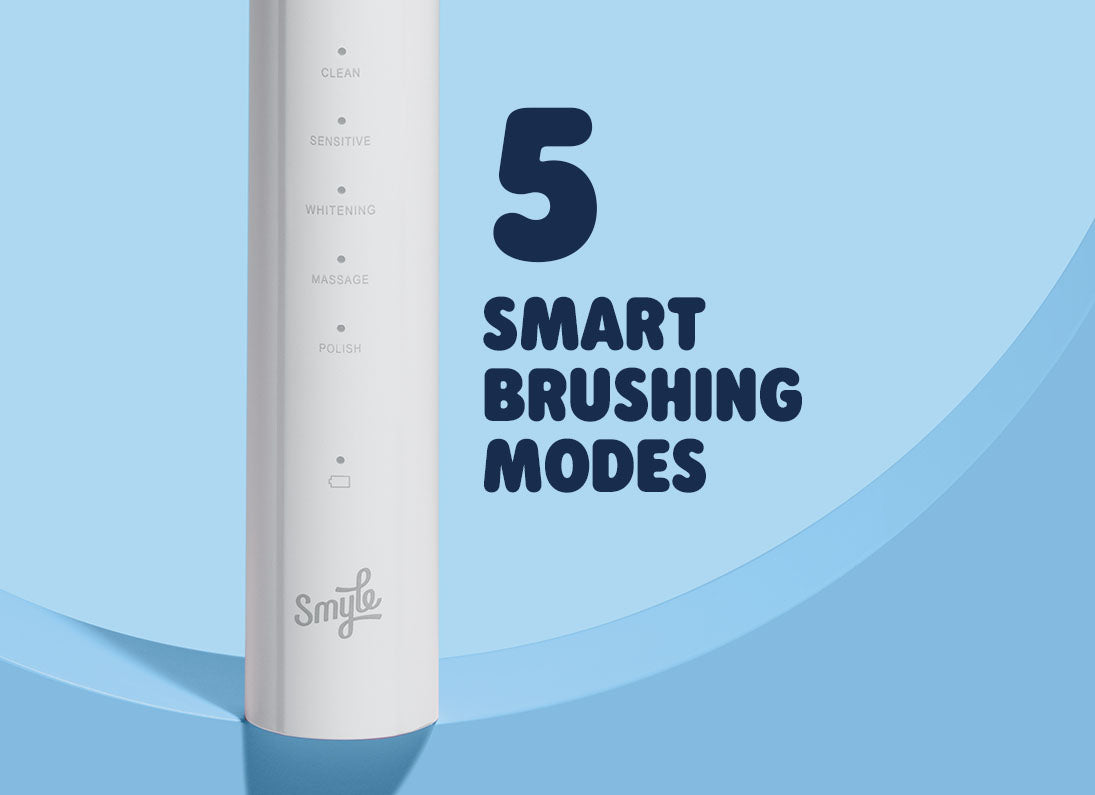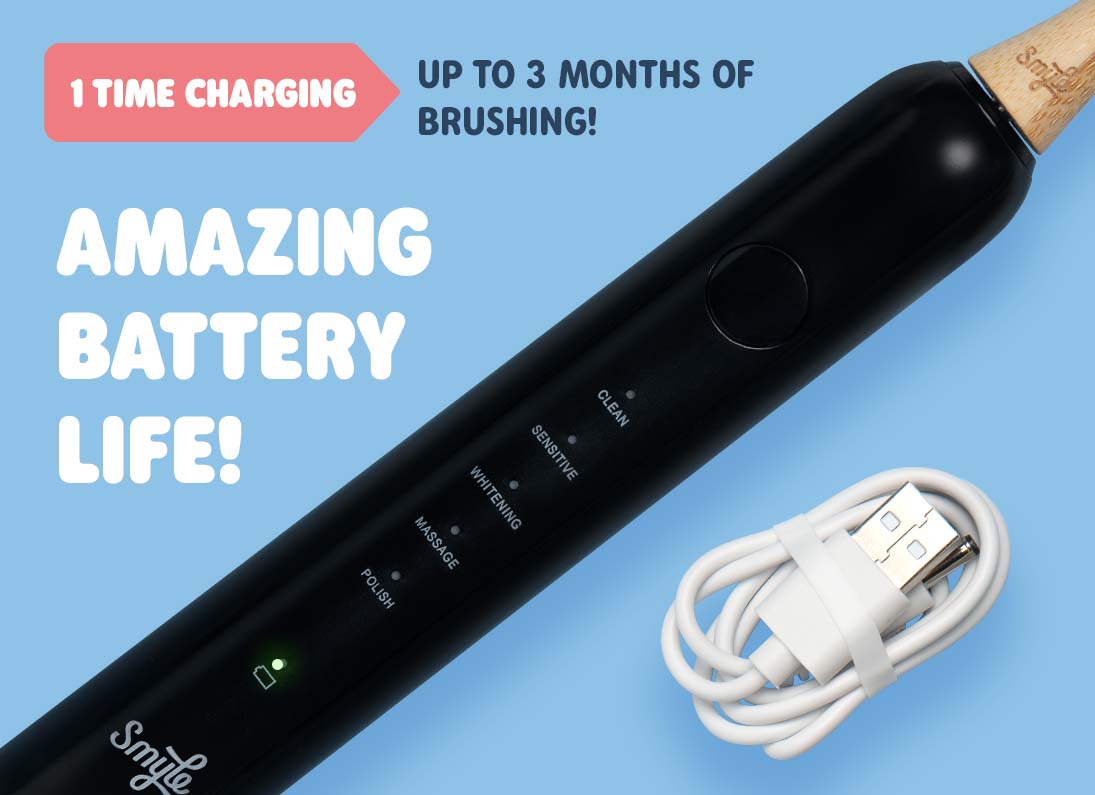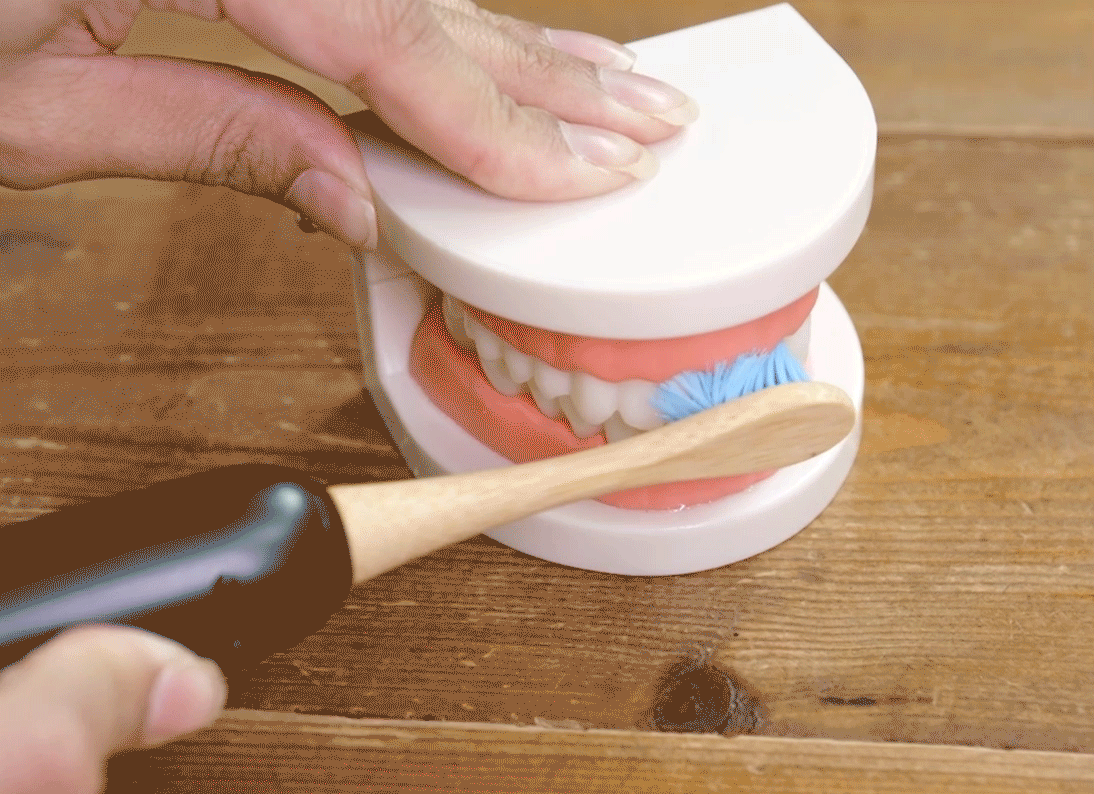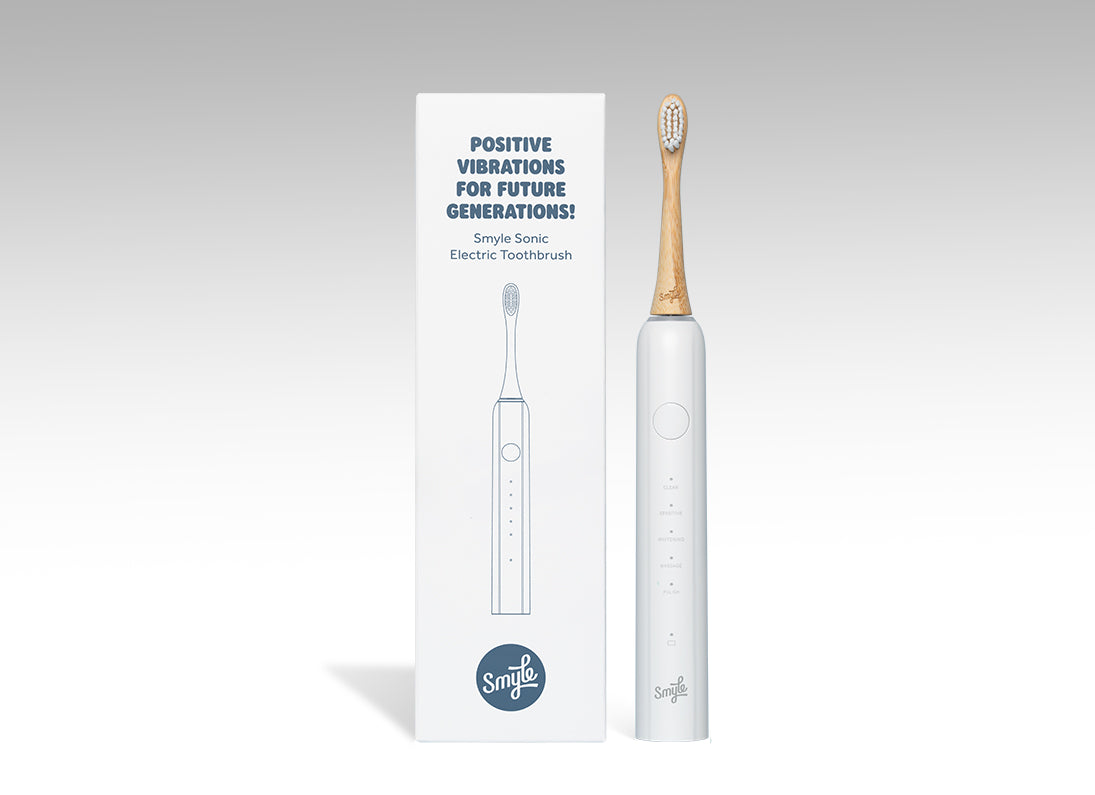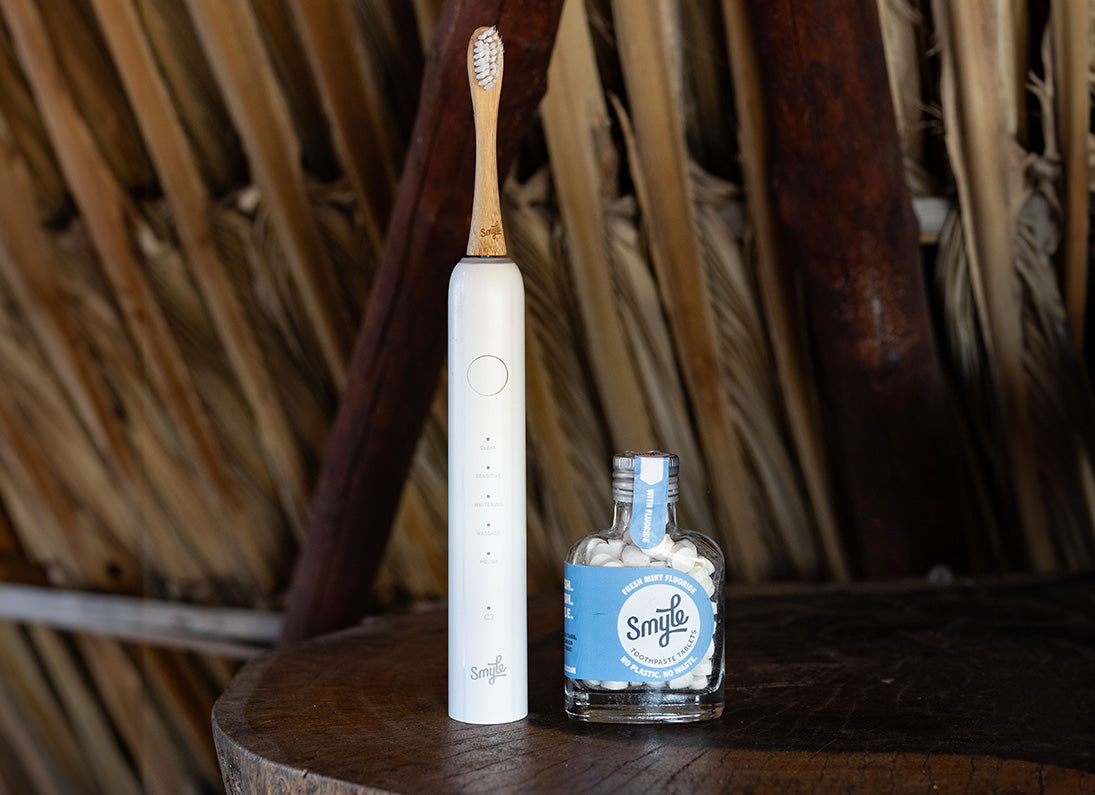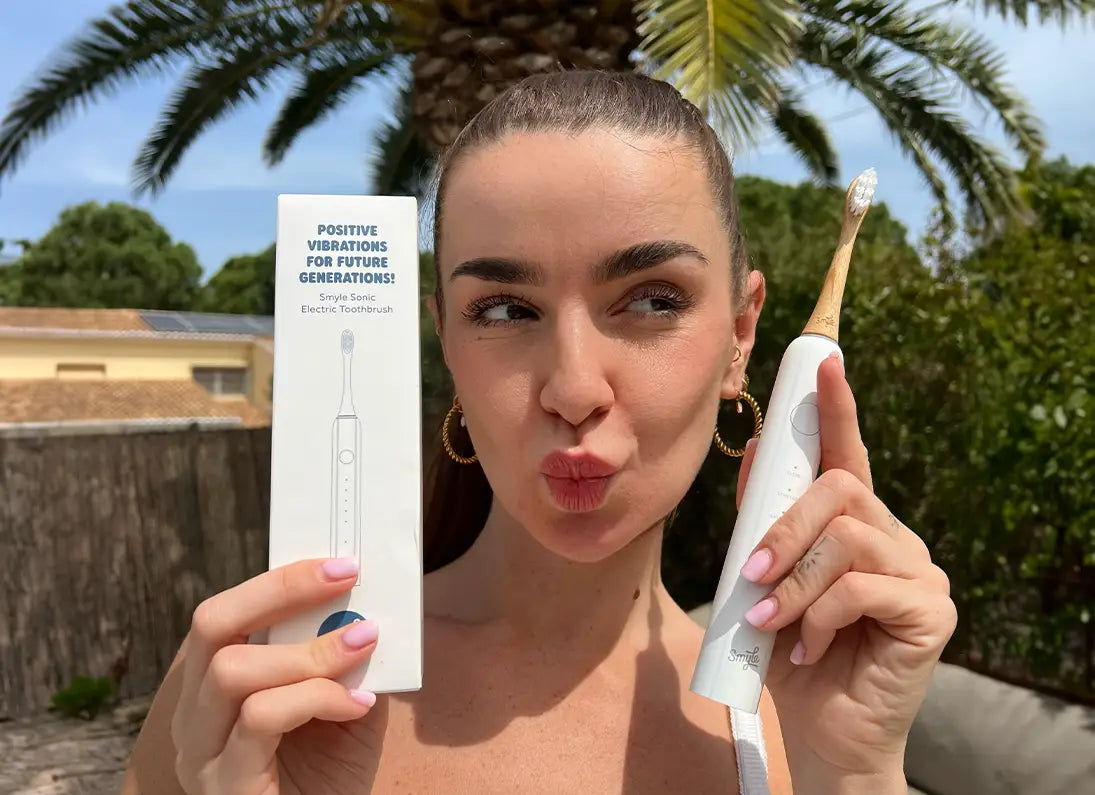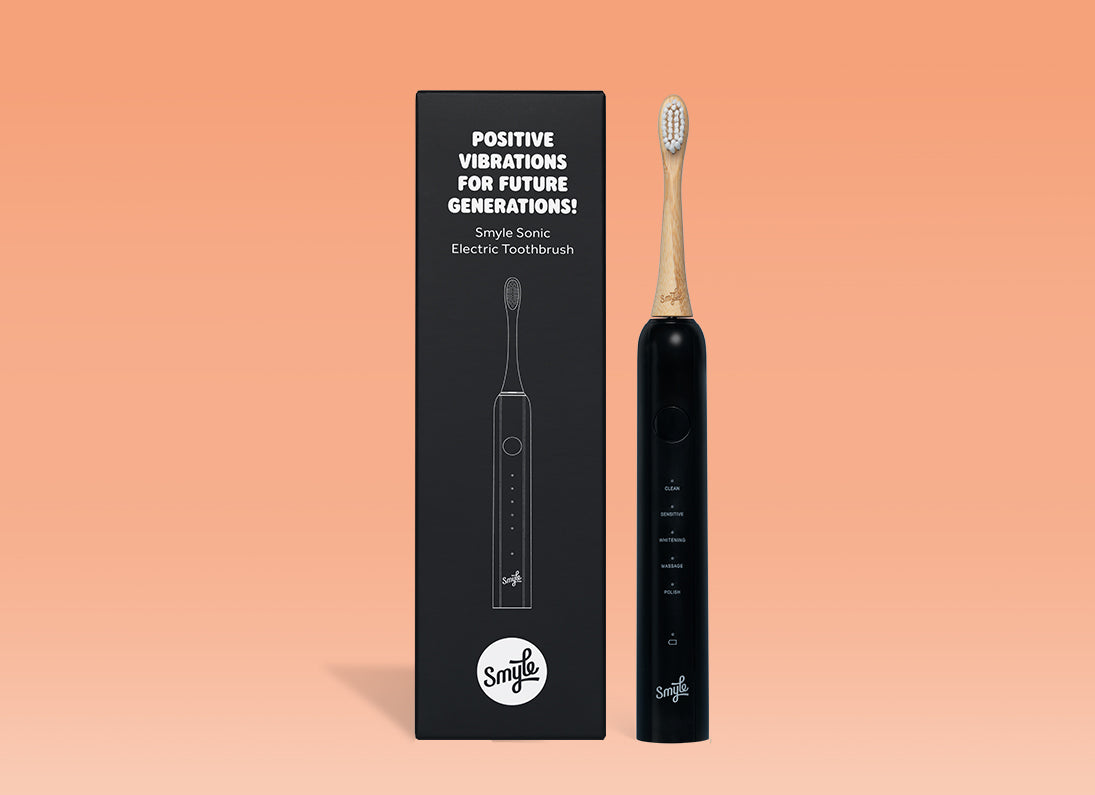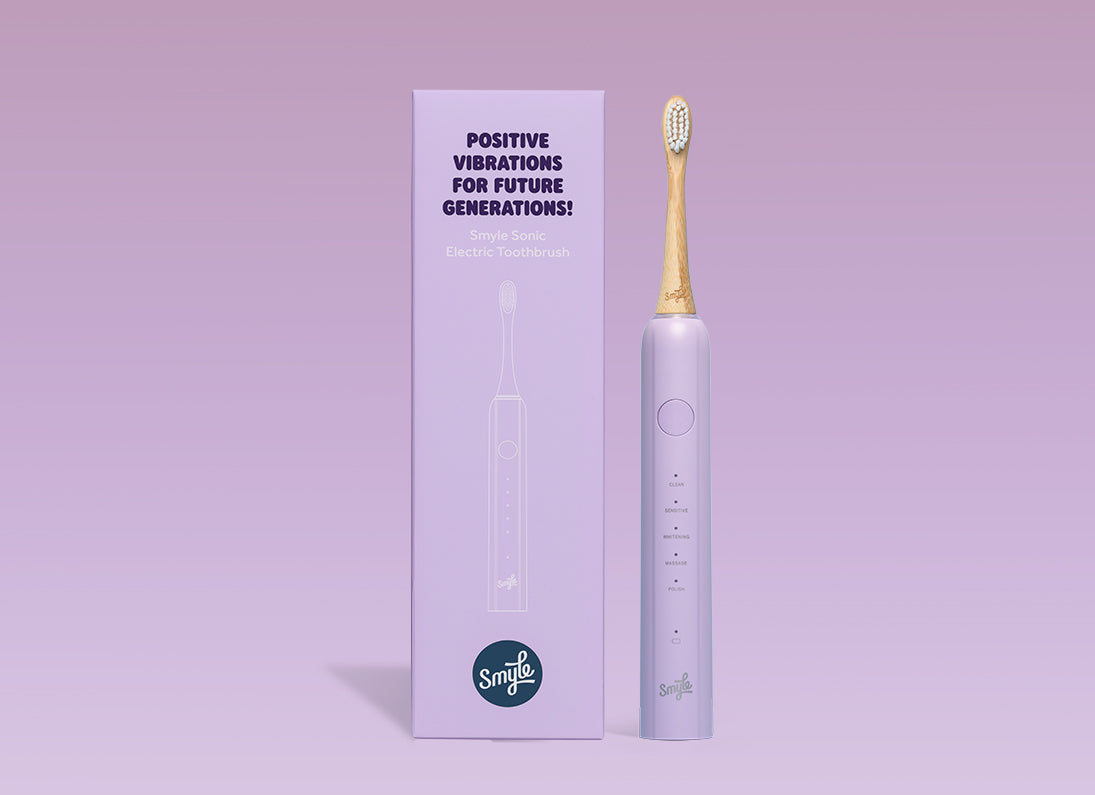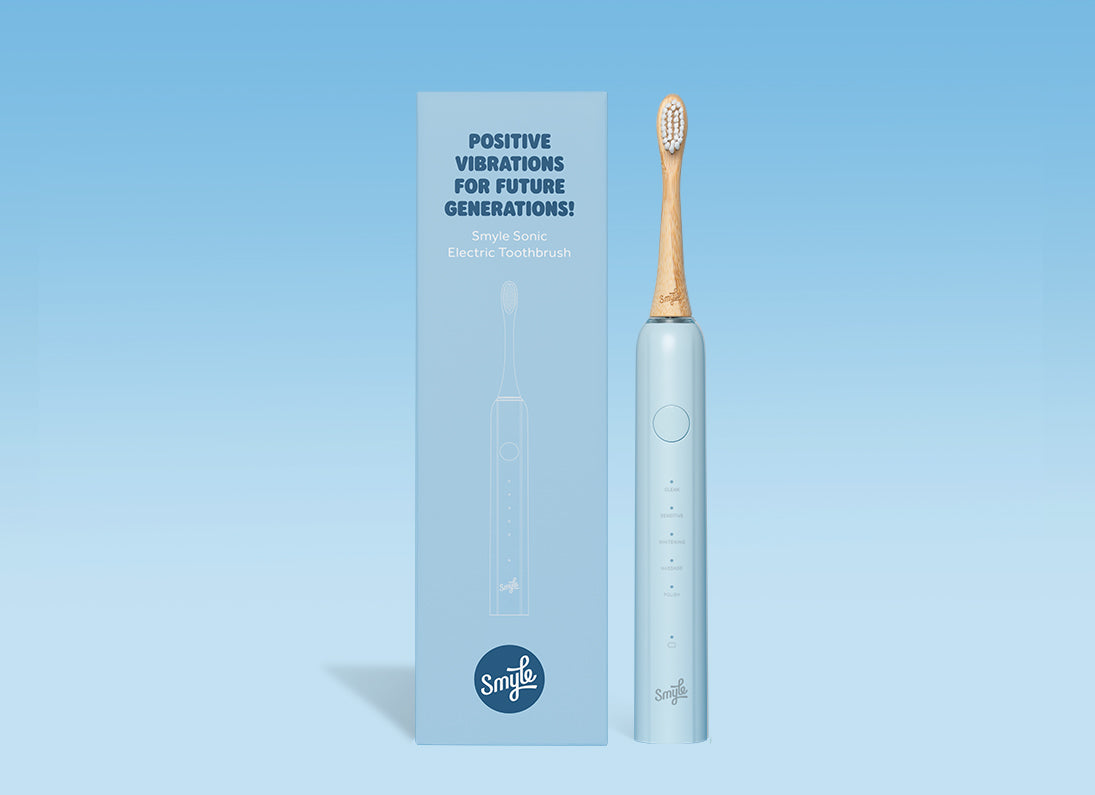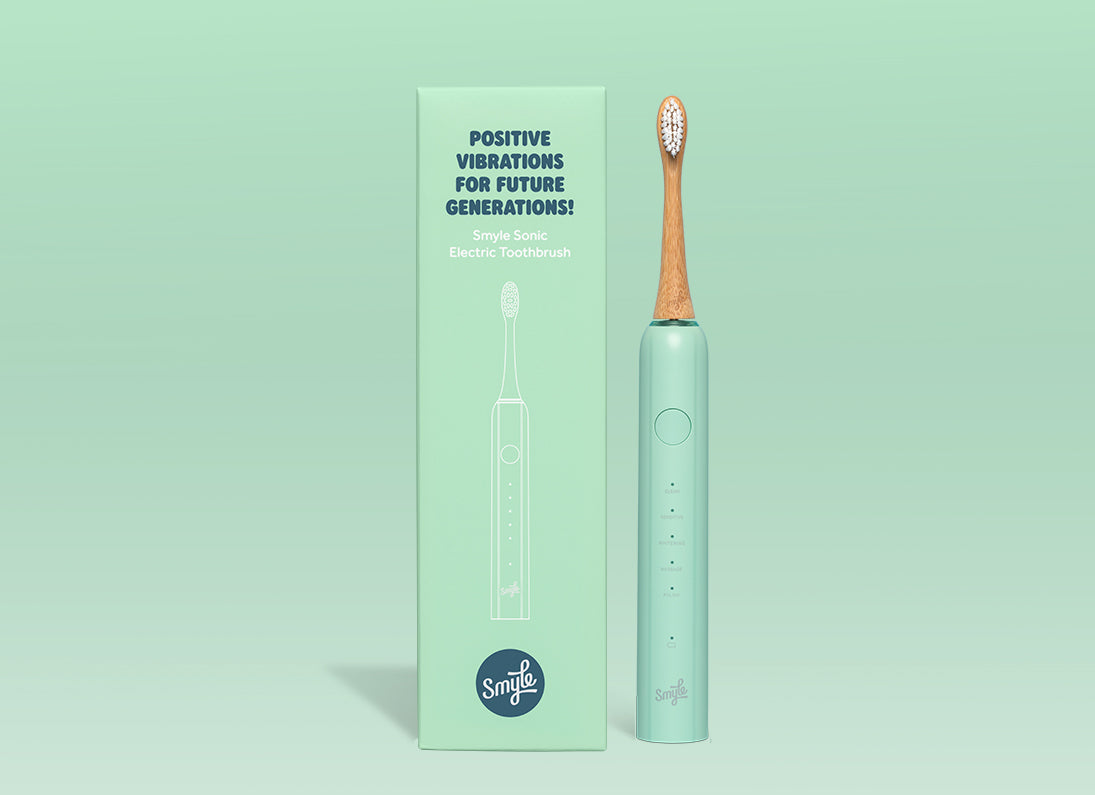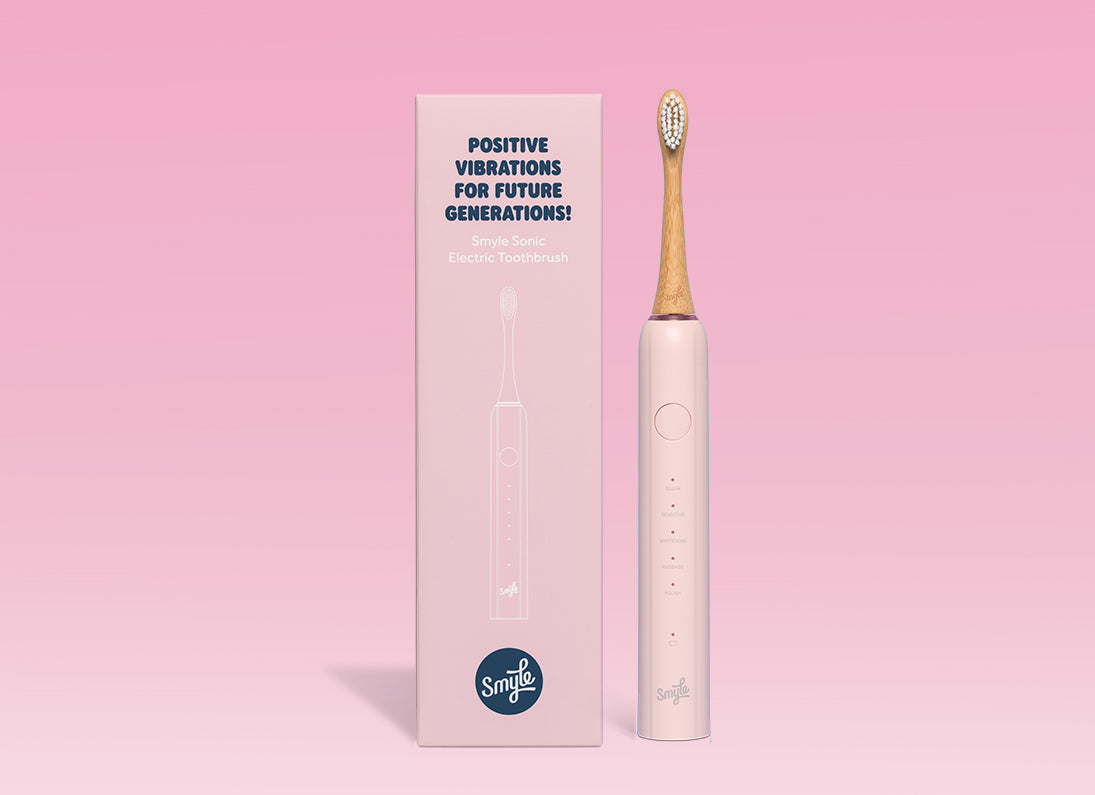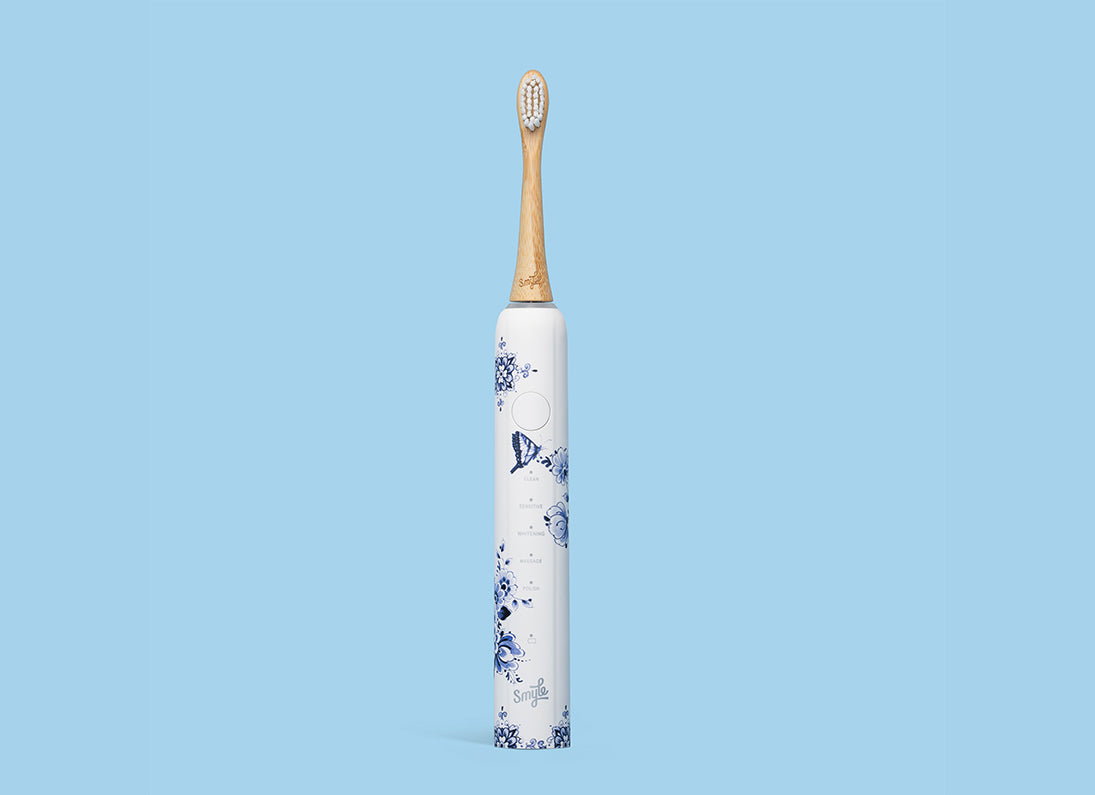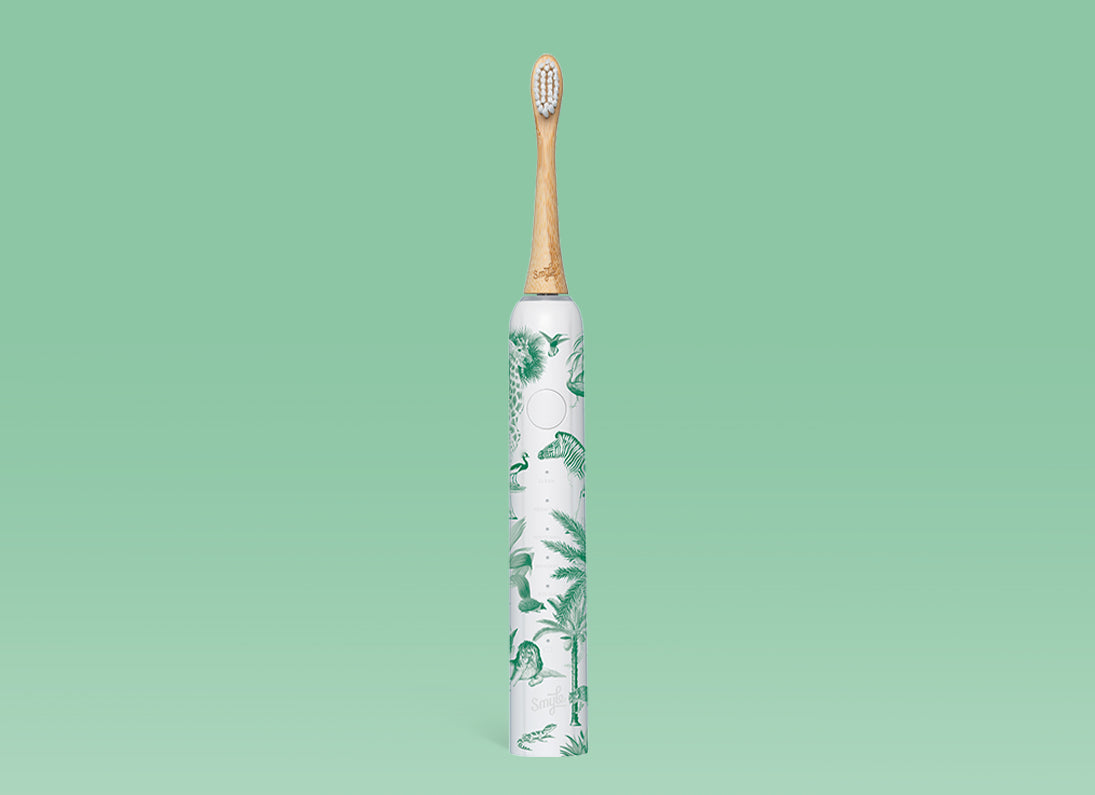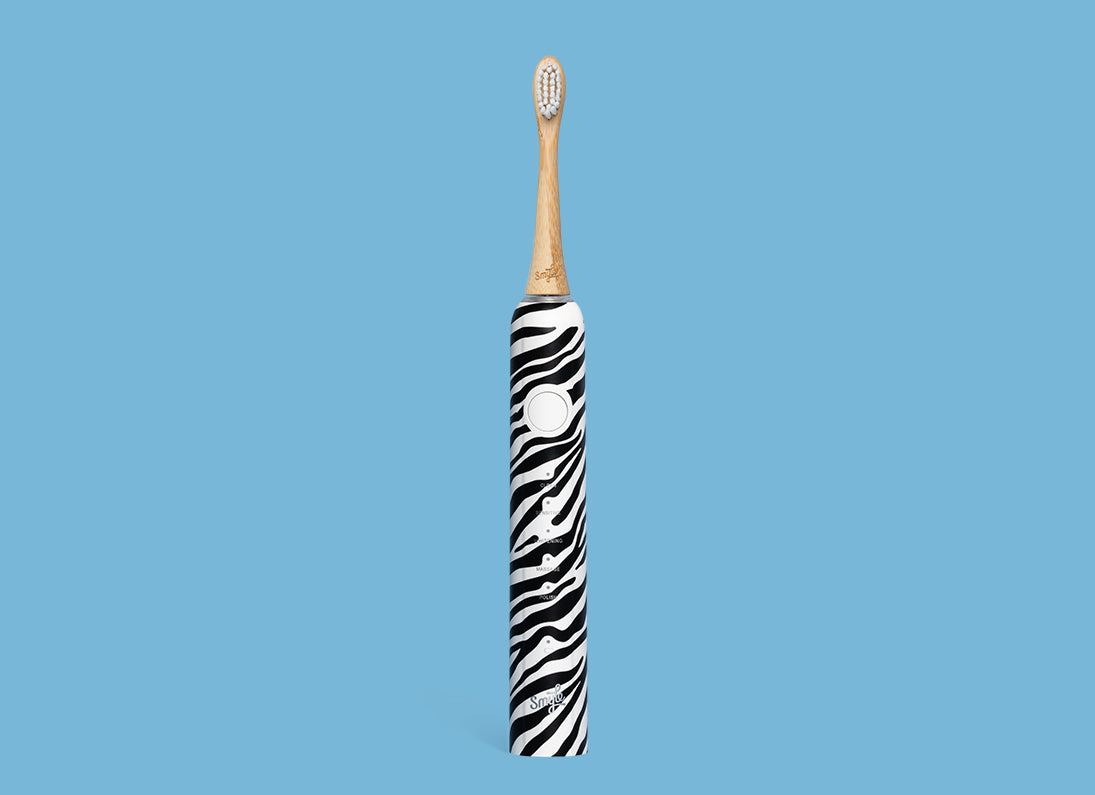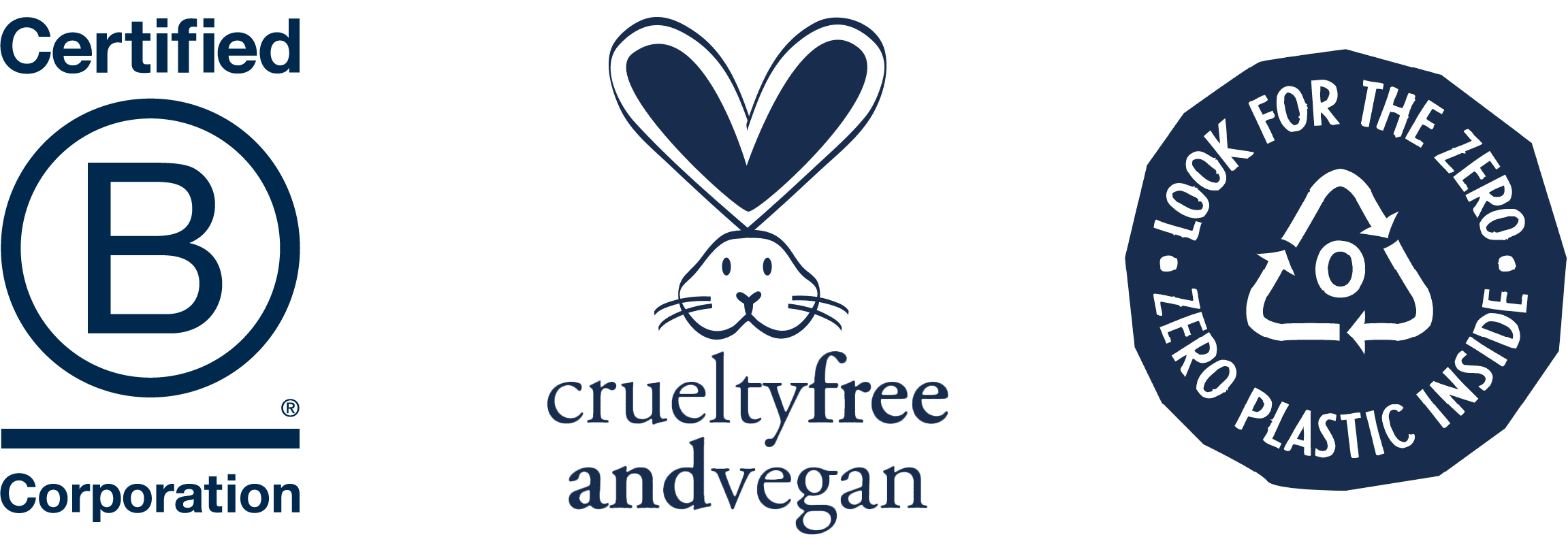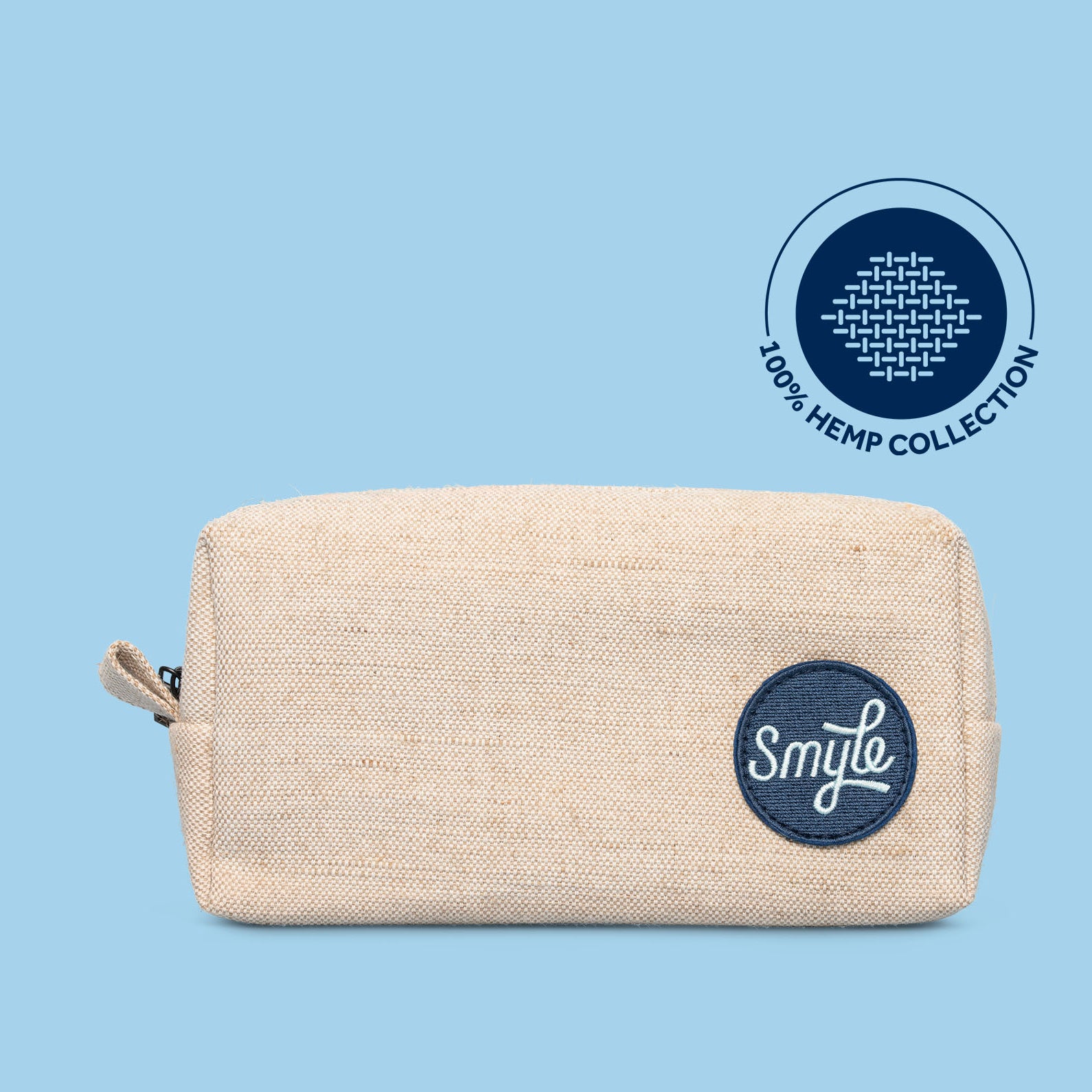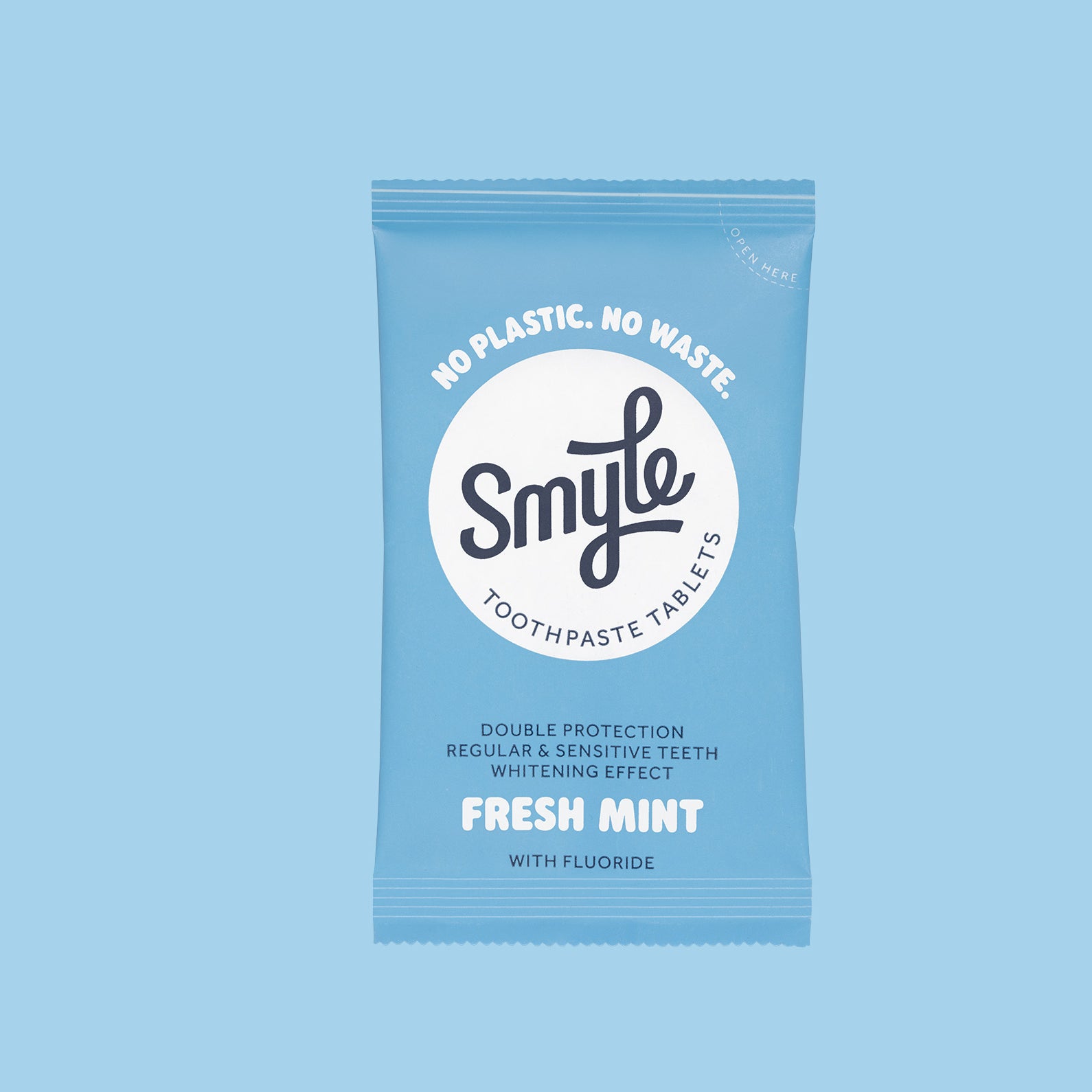
Tartar: you’ve probably heard of it. It’s a hard, calcified layer that forms on the teeth and molars due to the buildup and hardening of plaque. This hard layer is mainly found in areas that are difficult to reach while brushing your teeth. If you don’t remove this layer, it can lead to gum inflammation, periodontitis, and other unpleasant problems that you definitely want to avoid. That’s why removing tartar is so important—and Smyle tells you everything you need to know about it.
What is tartar?
Tartar is a hard and calcified material that builds up on the tooth surface and beneath the gumline. It forms when plaque—a sticky layer of bacteria and food particles—is not thoroughly removed, and minerals in the saliva cause it to harden. This process is known as mineralization. Tartar can appear in various colors, ranging from yellow to brown, and is usually visible as hard deposits on the tooth surface, especially around the gumline. When you run your finger over tartar, it feels rough and can give the teeth an uneven surface. In addition to visible tartar, it can also be present below the gumline, which is harder to detect without professional dental equipment. It’s important to note that the presence of tartar can be accompanied by various symptoms, such as bad breath, swollen or bleeding gums, and tooth discoloration. These symptoms may indicate gum inflammation, caused by the presence of tartar and its harmful effects on the gum tissue. That’s why removing tartar is extremely important for maintaining oral health and preventing further complications.
Why is removing tartar so important?
Removing tartar is extremely important for maintaining good oral health. It’s more than just a cosmetic issue. Tartar, which builds up on the teeth and beneath the gumline, can have serious consequences for both your mouth and your overall well-being:
Gum inflammation (gingivitis)
First of all, tartar can lead to inflammation of the gums, also known as gingivitis. The presence of tartar on the teeth and along the gumline irritates the gums and can cause them to become red, swollen, and sensitive. This may lead to bleeding during brushing or flossing. If this issue is not treated as soon as possible, it can progress into a more severe form of gum disease, such as periodontitis.
From gingivitis to periodontitis
Periodontitis is an advanced form of gum disease in which the inflammation spreads to the deeper tissues and bone structures surrounding the teeth. Over time, this can lead to the loss of teeth and bone tissue. In addition, there is evidence that periodontitis is linked to other health issues, such as cardiovascular disease, diabetes, and even pregnancy complications. By removing tartar regularly, these risks can be reduced and oral health can be protected.
Reduced self-confidence
Because tartar can have a yellow or brown color, it can make the teeth appear neglected and discolored. This may lead to reduced self-confidence and self-consciousness, especially when smiling or speaking in social situations. Regular removal of tartar helps restore the natural whiteness and brightness of the teeth, resulting in a radiant smile.
Bad breath
In addition, tartar can also cause other problems, such as bad breath. The bacteria that build up on tartar produce odorous compounds that cause a very unpleasant mouth odor. This can affect social and personal interactions. Regularly removing tartar helps to reduce bad breath and therefore contributes to fresh breath.
Tartar removal: how does it work?
After all this information, you’re probably wondering: “So how do you actually remove tartar?” This is usually done by a dental professional, such as your dentist or dental hygienist.
Professional tartar removal is carried out by dental professionals, usually dentists or dental hygienists. The most common technique is scaling and polishing. During this procedure, the dentist or hygienist uses a special instrument called a scaler to gently remove tartar from the teeth and beneath the gumline. After scaling, the teeth are polished using a rotating brush and a polishing paste to smooth out any rough surfaces. Another professional method is ultrasonic cleaning. This involves the use of an ultrasonic scaler, which generates vibrations and sound waves to loosen and remove tartar. This is an effective and efficient technique often used for larger amounts of tartar. In addition, more advanced techniques are also available, such as laser treatments. Lasers are used to vaporize tartar and kill bacteria. This method can be more precise and cause less discomfort than traditional scaling techniques, but it may not be available everywhere and can be more expensive.
Besides professional treatments, there are also several methods to remove tartar at home. Tartar-control toothpastes, for example, are available at drugstores and supermarkets. These toothpastes contain special ingredients, such as enzymes or abrasives, that help dissolve or remove tartar. It’s important to note that these toothpastes are only effective for removing surface-level tartar and not for deeper tartar buildup.
While it is possible to remove tartar at home, it’s important to understand that professional treatments are often more effective and thorough. A dentist or dental hygienist can remove tartar from hard-to-reach areas and detect any other oral health issues. That’s why it’s strongly recommended to have regular dental check-ups and cleanings—even if you use a special toothpaste to remove tartar at home.
What you can do yourself
Removing tartar on your own is quite difficult. However, there are several steps you can take to prevent tartar and maintain good oral health.
- Brushing your teeth
It all starts with a consistent and effective oral hygiene routine. First of all, brushing your teeth regularly is super important. Brush your teeth at least twice a day for two minutes, preferably with a fluoride toothpaste and/or an electric toothbrush. Make sure to brush all tooth surfaces thoroughly, including the backs of your teeth and your tongue. Using a soft-bristled toothbrush and applying gentle, circular motions helps effectively remove plaque—the precursor to tartar.
- Flossing
In addition to brushing, flossing is a crucial step in your oral hygiene routine. Floss daily to remove plaque and food particles from between your teeth—areas that a toothbrush can’t easily reach. It’s important to floss carefully to avoid injuring the gums. Use a silk dental floss or floss picks, and make sure to move gently back and forth between each tooth.
- Tongue scraping
Alongside the above steps, tongue scraping is another effective method to improve oral hygiene and help prevent tartar. Using a tongue scraper helps remove bacteria, dead cells, food debris, and other harmful substances that can accumulate on the surface of the tongue. This is important because the tongue can be a breeding ground for bacteria that cause plaque and tartar.
- Mouthwash
Mouthwash can also be a valuable addition to your oral care routine. An antiseptic mouthwash can help reduce the bacteria that cause plaque. Choose a mouthwash that is dentist-approved and follow the instructions on the packaging for the best results. However, it’s important to remember that mouthwash is not a substitute for brushing and flossing—but rather a supplement to them!
By following a consistent oral hygiene routine and attending regular dental check-ups, you can effectively prevent tartar and optimize your oral health!
Frequently Asked Questions About Tartar Removal
To help you fully understand everything about tartar and how to remove it, we've answered some frequently asked questions just for you.
Does tartar removal hurt?
Tartar removal is generally painless. During a professional cleaning, you may experience some minor discomfort, such as light pressure or vibrations, but this is usually tolerable. The dentist or dental hygienist will make sure you’re comfortable and can use a numbing gel if needed to desensitize any sensitive areas. It’s important to remember that any pain or sensitivity you may feel during the cleaning is temporary and typically goes away quickly. The end result of a thorough tartar removal is a cleaner and healthier mouth—so there's no need to worry! If you have any concerns or anxiety about the procedure, it’s always a good idea to discuss them with your dentist or hygienist so they can reassure you and help put you at ease.
How often should tartar be removed?
It is generally recommended to have tartar professionally removed at least twice a year (every 6 months) during routine dental check-ups. However, the frequency of tartar removal can vary depending on individual needs and oral health. Some people may be more prone to tartar buildup and require more frequent professional cleanings. Others, who maintain excellent oral hygiene and develop very little tartar, may be able to go longer between cleanings.
Can tartar disappear on its own?
No, tartar cannot disappear on its own. It can only be removed using professional dental instruments. Tartar, which forms from the buildup of minerals and bacterial plaque on the teeth and molars, creates a hard and rough surface that cannot be removed by regular brushing or flossing. Unlike plaque—a soft and sticky substance that can be easily removed—tartar adheres firmly to the tooth surface and can only be effectively removed by a dentist or dental hygienist.
Can you prevent tartar if you wear braces?
It’s understandable that preventing tartar can be a bit more difficult during orthodontic treatment with braces. The presence of all the wires, brackets, and other components makes brushing and flossing your teeth and gums more challenging. Still, it remains absolutely essential to maintain good oral hygiene—especially during this period—and to have tartar removed regularly by a professional dentist or dental hygienist.
What should I do if I have sensitive teeth or gums after tartar removal?
After a tartar removal, some people may experience sensitive teeth or gums. This can be caused by various factors, such as the removal of tartar, the scraping of the tooth surface, or sensitivity due to exposed tooth nerves. Fortunately, there are several steps you can take to reduce sensitivity and relieve discomfort following a tartar removal.
- Avoid hot or cold food and drinks: Temporary sensitivity after tartar removal can make your teeth more reactive to extreme temperatures. Try to avoid hot coffee, tea, ice cream, and other very hot or cold foods and beverages until the sensitivity subsides.
- Use a special toothpaste for sensitive teeth: There are toothpastes on the market specifically designed for sensitive teeth. These toothpastes contain ingredients like potassium nitrate or strontium chloride that can help reduce sensitivity. Brush your teeth gently with this type of toothpaste, preferably using a soft-bristled toothbrush.
- Use a fluoride mouthwash: Rinse your mouth with a fluoride mouthwash after brushing. Fluoride can help strengthen tooth enamel and reduce sensitivity.
- Avoid acidic foods and drinks: Acidic foods and beverages can weaken tooth enamel and worsen sensitivity. Try to avoid citrus fruits, soft drinks, sour candies, and other acidic products until the sensitivity subsides.
- Use a soft toothbrush and brush gently: Choose a soft toothbrush and brush gently rather than scrubbing forcefully. This helps prevent further irritation of the gums and reduces sensitivity.
- Consider pain relief: If the sensitivity persists after tartar removal and causes discomfort, you may use pain relievers such as ibuprofen, following the manufacturer's instructions. However, always consult your dentist or dental hygienist before taking any pain medication.
- Consult your dentist or dental hygienist: If the sensitivity doesn’t go away over time or gets worse, it’s important to contact your dentist or hygienist. They can assess the cause of the sensitivity and provide additional treatments or recommendations if needed.
Tartar removal for a radiant smile
The health of our mouth is incredibly important for our overall well-being, and removing tartar plays a crucial role in maintaining a healthy mouth. By understanding the information in this blog post, you now have a deeper insight into tartar, its effects, and the ways to prevent and remove it. No matter what, it’s truly important to regularly pay attention to your oral hygiene—such as brushing your teeth, flossing, and using mouthwash—to reduce tartar buildup. But don’t forget those regular dental check-ups! By taking these steps, you’re investing in your oral health and contributing to better overall health. Keep taking your oral care seriously and take responsibility for a radiant smile and a healthy lifestyle—just like you deserve.

